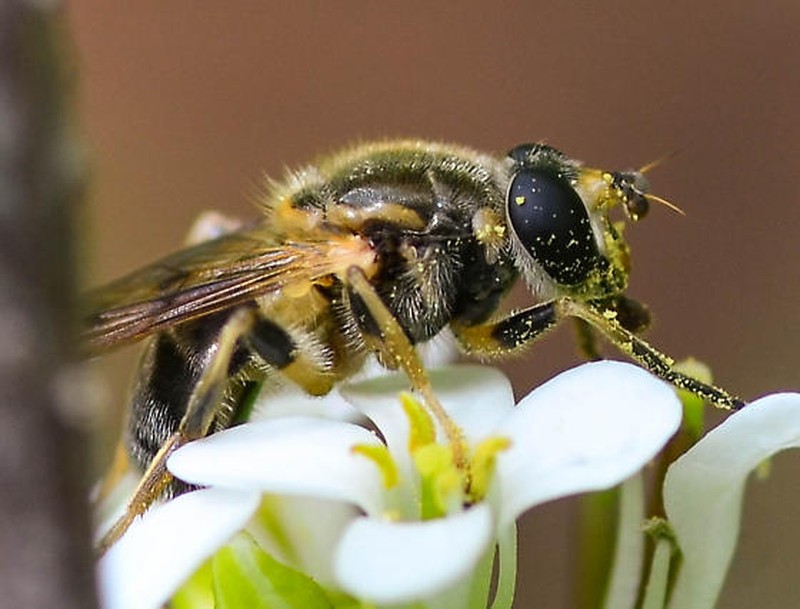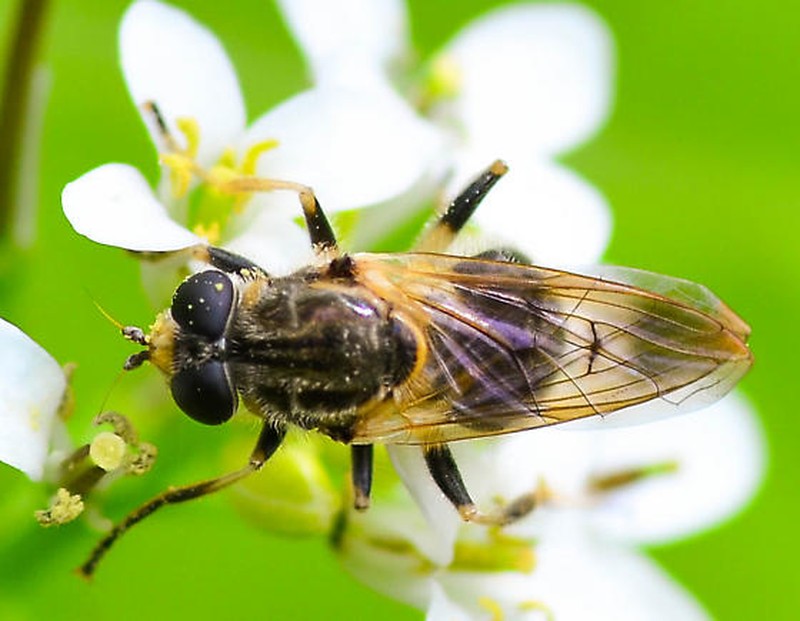Painted Wood Fly
Blera pictipes (Bigot, 1883)
- Class
- Insecta (Insects)
- Family
- Syrphidae
- State Protection
- Not Listed
Not listed or protected by New York State.
- Federal Protection
- Not Listed
- State Conservation Status Rank
- S1
Critically Imperiled in New York - Especially vulnerable to disappearing from New York due to extreme rarity or other factors; typically 5 or fewer populations or locations in New York, very few individuals, very restricted range, very few remaining acres (or miles of stream), and/or very steep declines.
- Global Conservation Status Rank
- G4G5
Apparently or Demonstrably Secure globally - Uncommon to common in the world, but not rare; usually widespread, but may be rare in some parts of its range; possibly some cause for long-term concern due to declines or other factors. More information is needed to assign either G4 or G5.
Summary
Did you know?
Female Syrphid flies require pollen in order for their ovaries to mature.
State Ranking Justification
The Painted Wood Fly is rare throughout its range (Skevington et al. 2019) and in New York, it is known from just four occurrences in the central and southeastern portion of the state, none of which is recent. It relies exclusively on old growth deciduous forests for breeding, a rare and threatened habitat.
Short-term Trends
This species has not been recorded in New York in 40 years.
Long-term Trends
It was documented only on Staten Island and Long Island in an early comprehensive list of the insects of New York (Leonard 1928), but has only been detected in New York two other times, both in Onondaga County in the late 1970s.
Conservation and Management
Threats
Because the larval habitat is confined to standing senescent trees or very old large decayed stumps found in intact stands of late successional forest, this Hover fly is threatened by modern forestry and land management practices that remove trees from stands before they can reach old age (>100 years) (Speight 2015).
Blera appear to be able to withstand severe genetic bottlenecks, thus allowing viable populations to perist in fragmented woodlands so long as the microclimatic integrity of the late successional forest ecosytem remains intact (Rotheray et al. 2012).
Conservation Strategies and Management Practices
The presence of this species is a clear indication of old growth forest conditions (Skevington et al. 2019). Forest management practices allowing for long rotation times (more than 100 years) are necessary to allow standing deciduous trees to reach the advanced stage where suitable rot-holes can form (Speight 2015).
The endangered Pine Hoverfly (B. fallax) has been actively managed as a conservation target in Scotland since the 1980s. Practical strategies such as breeding habitat creation/improvement and even captive rearing and translocations have shown promising results (Rotheray and Rotheray 2012).
Research Needs
Very little is known about any of the 16 Blera species found in North America. Research into any aspect of their biology would be a valuable contribution.
Habitat
Habitat
These pollinators live in old growth deciduous forests (Skevington et al. 2019) with senescent trees where the larvae live in tree rot-holes, wet heart rot cavities and decaying stumps. Greene (1923) found pupa in the frass of a dead Tuliptree (Liriodendron tulipifera) stump in mid April in Virginia. Because the larvae are filter feeders, conditions within the forest must remain stable and humid (Rotheray et al. 2001).
Associated Ecological Communities
- Allegheny oak forest*
(guide)
A hardwood forest that occurs on well-drained sites in the unglaciated portion of southwestern New York. This is a forest of mixed oaks with a diverse canopy and richer ground flora than other oak communities in the state.
- Appalachian oak-hickory forest*
(guide)
A hardwood forest that occurs on well-drained sites, usually on ridgetops, upper slopes, or south- and west-facing slopes. The soils are usually loams or sandy loams. This is a broadly defined forest community with several regional and edaphic variants. The dominant trees include red oak, white oak, and/or black oak. Mixed with the oaks, usually at lower densities, are pignut, shagbark, and/or sweet pignut hickory.
- Floodplain forest*
(guide)
A hardwood forest that occurs on mineral soils on low terraces of river floodplains and river deltas. These sites are characterized by their flood regime; low areas are annually flooded in spring, and high areas are flooded irregularly.
- Oak-tulip tree forest*
(guide)
A hardwood forest that occurs on moist, well-drained sites in southeastern New York. The dominant trees include a mixture of five or more of the following: red oak, tulip tree, American beech, black birch, red maple, scarlet oak, black oak, and white oak.
- Rich mesophytic forest
(guide)
A hardwood or mixed forest that resembles the mixed mesophytic forests of the Allegheny Plateau south of New York but is less diverse. It occurs on rich, fine-textured, well-drained soils that are favorable for the dominance of a wide variety of tree species. A canopy with a relatively large number of codominant trees characterizes this forest. Canopy codominants include five or more of the following species: red oak, red maple, white ash, American beech, sugar maple, black cherry, cucumber tree, and black birch.
* probable association but not confirmed.
Range
New York State Distribution
New York lies along the northern range margin of this more southerly species. It is known only from a few scattered locations in central and extreme southeastern New York.
Global Distribution
The Painted Wood Fly occurs from Oklahoma and northern Florida, north to southern Michigan and southeastern Maine (Skevington et al. 2019).
Identification Comments
General Description
The (semi) aquatic larvae of Blera species are maggot-like, except that they possess a long, flexible breathing tube, which allows them to remain submerged in the wet detritus of tree rot holes for extended periods (Rotheray and Rotheray 2012). A puparium is figured in Greene (1923).
Identifying Characteristics
This is a distinctive bee-like fly. The adults are about an inch long, having an entirely orange face and yellow markings on tergite 2. The scutum is yellow above the wings and the scutellum is yellow apically (Skevington et al. 2019).
Characters Most Useful for Identification
The yellow-orange face and frons, along with its distinctive abdominal markings, distinguish this Wood Fly from other similar flies.
Best Life Stage for Proper Identification
Hover fly puparia and larvae are identifiable (Rotheray 1993), but adults are the easiest to id.
Behavior
Males fly fast and low in forest clearings near Rubus clumps and are thought to be territorial. They appear to copulate with females in the vicinity of flowers where both sexes feed (Maier 1982; Maier and Waldbauer 1979).
Diet
Adults are known to take nectar and pollen from Physocarpus and Prunus (Skevington et al. 2019). Other Blera species also visit Heracleum, Viburnum, Cornus, Sassafrass, Crataegus, Hydrastis, Rhododendron, Acer, Rosa, Rubus, Berberis, Valeriana, Potentilla. The larvae are saprophagous filter feeders in old, senescent (standing) tree rot holes. They are adapted for gathering and concentrating micro-organisms suspended in a fluid medium (Rotheray 2013).
Best Time to See
This is a spring species, adults are most likely to be observed in mid- May to early July.
Up to 20% of larvae in a population might extend development for two years (diapause) since they are known to be freeze tolerant. This indicates a semi-voltine development strategy, thereby helping to circumvent population extirpation during unfavorable breeding conditions (cool, rainy June) in a given year (Rotheray et al. 2015).
- Reproducing
- Larvae present and active
The time of year you would expect to find Painted Wood Fly reproducing and larvae present and active in New York.
Similar Species
- Common Wood Fly (Blera badia)
Blera pictipes is similar to other Blera species, but the abdominal markings on B. pictipes are characteristic.
Painted Wood Fly Images
Taxonomy
Painted Wood Fly
Blera pictipes (Bigot, 1883)
- Kingdom Animalia
- Phylum Arthropoda
(Mandibulates)
- Class Insecta
(Insects)
- Order Diptera
(Flies and Keds)
- Family Syrphidae
- Order Diptera
(Flies and Keds)
- Class Insecta
(Insects)
- Phylum Arthropoda
(Mandibulates)
Additional Resources
References
Cicero, M., E.M. Barrows. 2000. Milesiine flower flies in a central Appalachian broadleaf forest: abundances, flight periods, and Dibenzofluron. Proceeding of the Entomological Society of Washington 102:50-57.
Greene, C.T. 1923. A contribution to the biology of N.A Diptera. Proceeding of the Entomological Society of Washington 25:82-90.
Ichige, K, A.V. Barkalov. 2017. A review of the Old World species of the genus Blera. Euroasian Entomological Journal 16:419-431.
Leonard, M. D. ed. 1928. A list of the insects of New York, with a list of the spiders and certain other allied groups. Cornell University Agricultural Experiment Station Mem. 101. Ithaca, New York. 1121 pp.
Maier, C. 1982. Larval habitats and mate-seeking sites of flower flies. Proceedings of the Entomological Society of Washington 84:603-609.
Maier, C., G.P. Waldbauer. 1979. Dual mate-seeking strategies in male syrphid flies. Annals of the Entomological Society of America 72:54-61.
Miranda, G.F.G., A.D. Young, M.M. Locke, S.A. Marshall, J.H. Skevington, and F.C. Thompson. 2013. Key to the genera of nearctic Syrphidae. Canadian Journal of Arthropod Identification No. 23 (August, 2013). Available online: http://cjai.biologicalsurvey.ca/mylmst_23/mylmst_23.html
New York Natural Heritage Program. 2024. New York Natural Heritage Program Databases. Albany, NY.
Rotheray, E.L. 2013. Differences in ecomorphology and microhabitat use of four saproxylic larvae (Diptera: Syrphidae) in Scots pine stump rot holes. Ecological Entomology 38:219-229.
Rotheray, E.L., D. Goulson, L.F. Bussiere. 2016. Growth, development, and life-history strategies in an unpredictable environment: case study of a rare hoverfly Blera fallax. Ecological Entomology 41:85-95.
Rotheray, E.L., O. Lepais, A. Nater, M. Krutzen, M. Greminger, D. Goulson, L.F. Bussiere. 2012. Genetic variation and population decline of an endangered hoverfly Blera fallax. Conservation Genetics 13:1283-1291.
Rotheray, G.E. Color Guide to Hoverfly Larvae in Britain and Europe. Dipterist's Digest 9:1-156.
Rotheray, G.E., EL. Rotheray. 2012. Translocating the Pine Hoverfly, Blera fallax. Antenna 36:36-41.
Rotheray, G.E., G. Hancock, S. Hewitt, D. Horsfield, I. MacGowan, D. Robertson, K. Watt. 2001. The biodiversity and conservation of saproxylic diptera in Scotland. Journal of Insect Conservation 5:77-85.
Skevington, J.H., M.M. Locke, A.D. Young, K. Moran, W.J. Crins, S.A. Marshall. 2019. Field Guide to the Flower Flies of Northeastern North America. Princeton University Press, 512 p.
Speight, M.C.D. 2015. Species accounts of European Syrphidae (Diptera), 2015 (Vol. 83). Dublin: Syrph the Net Publications.
Thompson, F.C. 2000. A new Blera (Diptera: Syrphidae). Entomological News 111:181-184.
Wheeler, A.G., E.R. Hoebke 1985. The insect fauna of Ninebark, Physocarpus opulifolius. Proceedings of the Entomological Society of Washington 87:356-370.
About This Guide
This guide was authored by: Jeff Corser
Information for this guide was last updated on: March 26, 2019
Please cite this page as:
New York Natural Heritage Program. 2024.
Online Conservation Guide for
Blera pictipes.
Available from: https://guides.nynhp.org/painted-wood-fly/.
Accessed July 27, 2024.


